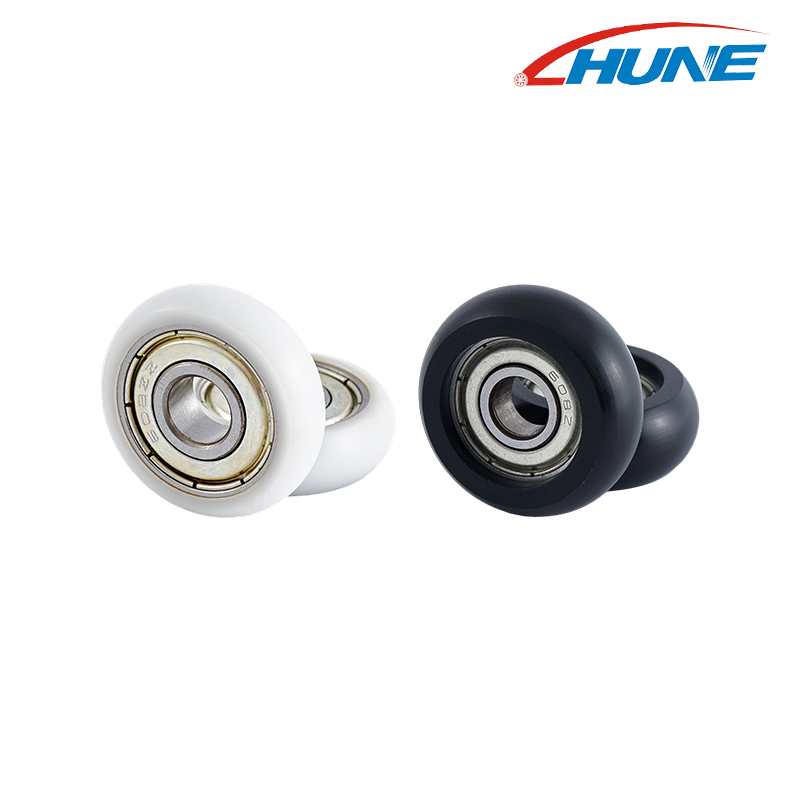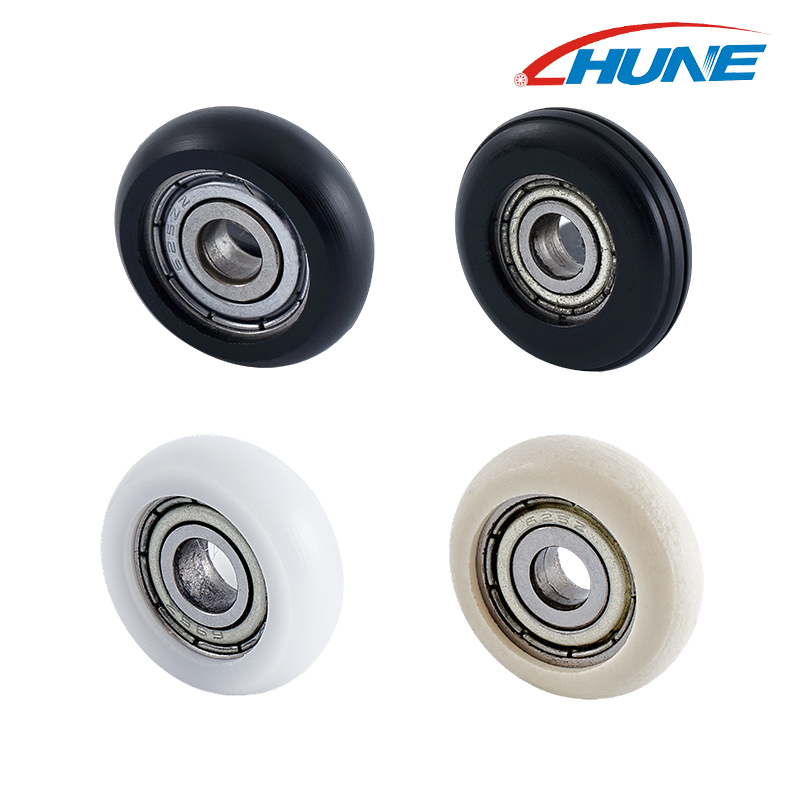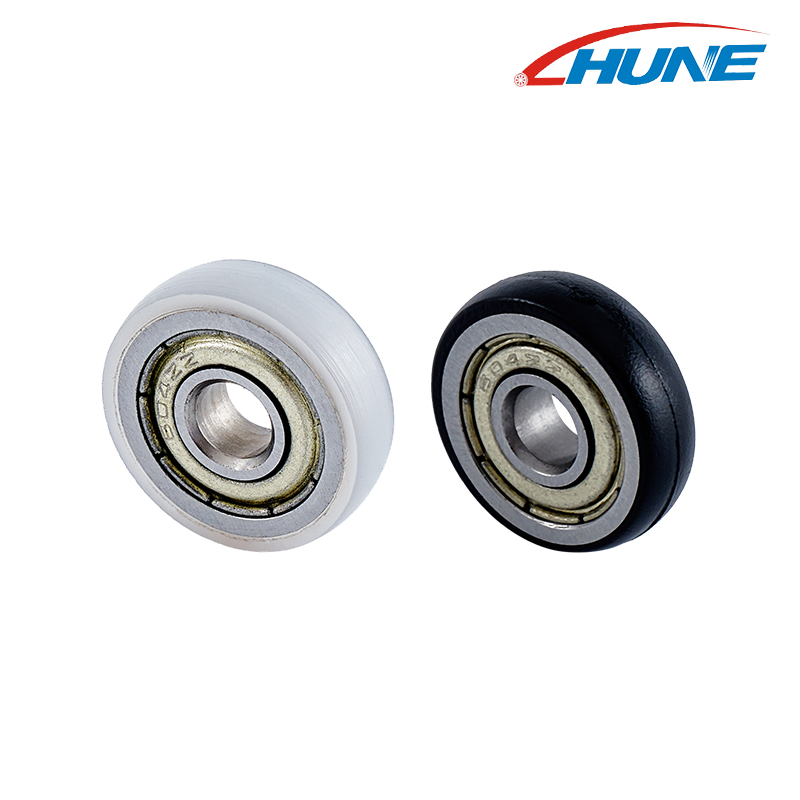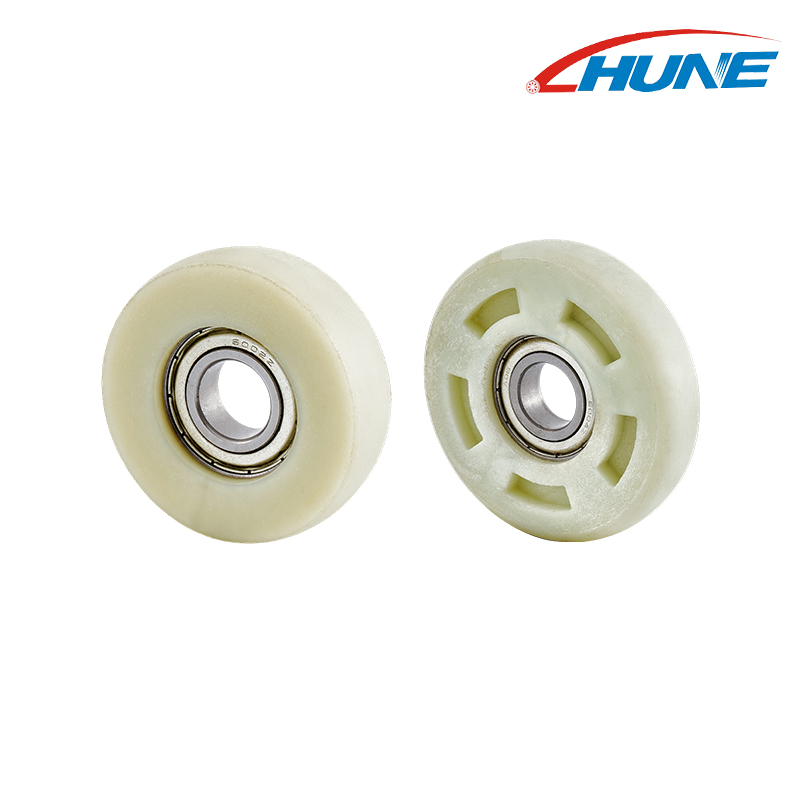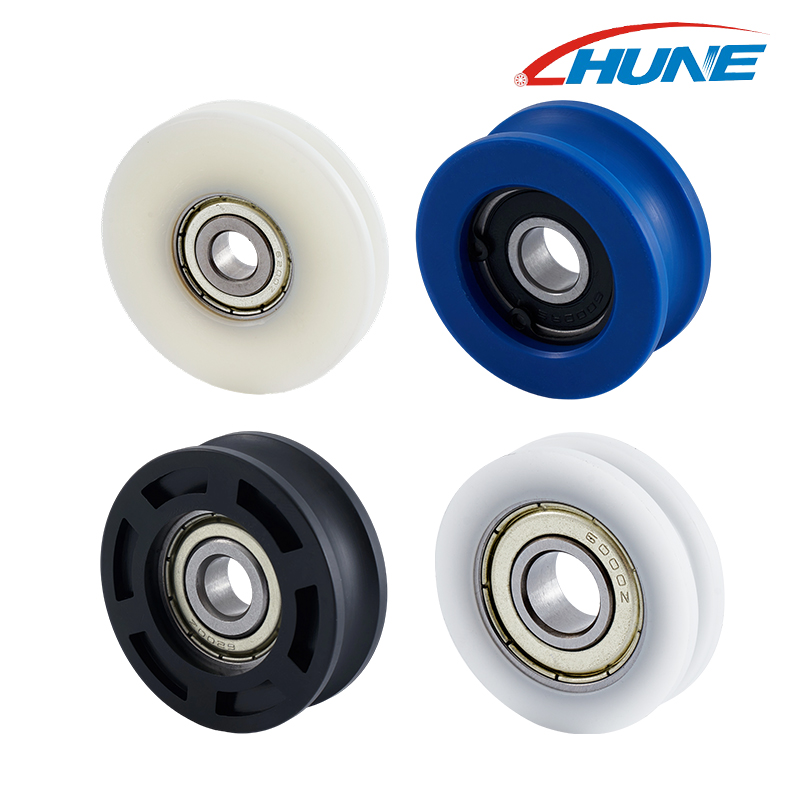1. Introduction to Plastic Bearing Pulleys
1.1 What is a Plastic Bearing Pulley?
A plastic bearing pulley is a mechanical component that incorporates a plastic pulley wheel with an integrated bearing at its center. This combination allows for the efficient transmission of rotational motion with minimal friction and noise. The pulley itself is typically made of durable plastic materials such as POM (Polyoxymethylene), Nylon, or other thermoplastics, while the bearing may be made of stainless steel, ceramic, or even engineered plastic for fully non-metallic systems.
Plastic bearing pulleys are used to guide or support cables, belts, and ropes in a wide range of mechanical and automated systems. The built-in bearing enhances rotational efficiency, supporting smooth and consistent movement even under varying loads and speeds. These pulleys come in various shapes and sizes to suit different applications, including industrial machines, household devices, 3D printers, and fitness equipment.
Unlike traditional metal pulleys, plastic versions are engineered to offer specific advantages such as reduced weight, chemical resistance, and quieter operation. Their versatility and functional efficiency have made them increasingly popular in industries where cost, maintenance, and material performance are crucial considerations.
1.2 Advantages of Plastic Bearing Pulleys over Metal Pulleys
Plastic bearing pulleys offer several distinct advantages over their metal counterparts, making them a smart choice in many applications:
1. Lightweight Construction
One of the most immediate and noticeable advantages of plastic pulleys is their low weight. Plastics like POM and Nylon are significantly lighter than steel or aluminum. This reduction in mass is beneficial in systems where weight savings are critical, such as in aerospace components, small robotic arms, or electric vehicles.
2. Corrosion Resistance
Unlike metals, plastic materials do not corrode or oxidize when exposed to moisture, chemicals, or salt air. This makes plastic bearing pulleys ideal for marine environments, outdoor equipment, and food processing systems where frequent exposure to harsh conditions is unavoidable.
3. Noise Reduction
Plastic pulleys tend to operate more quietly than metal ones due to the inherent damping characteristics of the material. This is particularly valuable in applications requiring low noise levels, such as in office machinery, medical devices, or residential appliances.
4. Self-Lubricating Properties
Many engineering plastics, especially POM, are naturally self-lubricating. This property minimizes the need for additional lubrication, reducing maintenance requirements and operational downtime. In some applications, especially in clean rooms or precision machines, eliminating external lubricants is a key advantage.
5. Lower Manufacturing Costs
Plastic parts are often cheaper to produce than their metal equivalents, especially in high volumes. Injection molding and CNC machining of plastics are cost-effective methods that allow for complex shapes and consistent quality. The reduced material cost, combined with easier manufacturing processes, contributes to overall savings.
6. Electrical Insulation
Certain plastic materials are electrically insulating, unlike metals that conduct electricity. This makes plastic pulleys safer in systems that involve electrical components or wiring, reducing the risk of short circuits or electrical faults.
7. Customization and Design Flexibility
Plastics are easily molded or machined into a variety of complex shapes and designs. This allows engineers to create pulleys that perfectly match specific application requirements, including integrated mounting holes, slots, or reinforced ribs for added strength.
8. Environmental and Chemical Resistance
Modern engineering plastics can resist exposure to oils, acids, alkalis, and other chemicals. This makes them highly suitable for use in chemical processing equipment, agricultural machines, and industrial plants where chemical exposure is a daily occurrence.
9. Reduced Wear on Mating Parts
The softer surface of plastic pulleys causes less wear on belts, ropes, or cables that run over them. This leads to longer service life for those components and reduces the need for frequent replacements.
10. Thermal Stability (in Select Plastics)
High-performance plastics can maintain their mechanical properties over a wide temperature range. This allows them to perform reliably in environments with extreme heat or cold, although careful selection of plastic type is necessary for such applications.
Use Case Scenarios
To better understand the benefits of plastic bearing pulleys in real-world scenarios, consider the following examples:
3D Printers: Plastic pulleys are widely used in desktop 3D printers due to their low noise output, lightweight design, and precise movement. They help reduce the total moving mass, resulting in higher print quality and faster operation.
Marine Equipment: In boats and ships, pulleys are exposed to salt water and humid conditions. Plastic bearing pulleys with stainless or ceramic bearings resist corrosion, ensuring long-term functionality.
Fitness Machines: Treadmills, rowing machines, and resistance training equipment often use plastic pulleys to guide cables and belts. Their quiet operation and durability make them ideal for home and commercial gyms.
Industrial Conveyor Systems: Plastic pulleys are frequently found in conveyor belts used in packaging lines and assembly processes. Their low-friction bearings improve energy efficiency and reduce belt wear.
Medical Devices: In hospital equipment, noise reduction, clean operation, and precise movement are essential. Plastic pulleys are a common choice due to their hygiene-friendly properties and smooth operation.
Evolution of Plastic Pulley Technology
Early plastic pulleys were limited in strength and load-bearing capacity, which confined their use to light-duty applications. However, advances in polymer science and material engineering have dramatically expanded their utility. Modern plastics are reinforced with additives or fillers, such as glass fibers or carbon black, improving tensile strength, heat resistance, and UV stability.
Today’s plastic bearing pulleys are no longer seen as inferior alternatives to metal; they are purpose-built components tailored for optimized performance. Additionally, hybrid designs are emerging that combine plastic pulley bodies with high-precision metal or ceramic bearings, offering the best of both worlds: durability and design flexibility.
2. Types of Plastic Bearing Pulleys
Plastic bearing pulleys are categorized based on two main criteria: the material used and the shape or design of the pulley. These classifications help manufacturers and engineers choose the best pulley for specific mechanical or environmental conditions. Each type has unique performance characteristics that determine its suitability for certain applications.
2.1 Based on Material
The material from which a plastic pulley is made significantly influences its performance. Factors such as wear resistance, operating temperature, chemical resistance, and strength vary depending on the chosen polymer.
2.1.1 POM (Polyoxymethylene) Pulleys
POM, also known as acetal or Delrin®, is one of the most widely used engineering plastics for pulleys due to its excellent mechanical properties. It combines high stiffness, low friction, and superior dimensional stability, making it suitable for precision movement and long-lasting use.
Key Features:
Excellent wear resistance and strength
Self-lubricating surface
Minimal moisture absorption
High resistance to oils, solvents, and fuels
Operational temperature range: -40°C to +100°C
Common Applications:
POM pulleys are popular in 3D printers, office automation devices, and conveyor systems where precision and smooth operation are important.
2.1.2 Nylon Pulleys
Nylon is another commonly used material for plastic pulleys. Compared to POM, Nylon is more flexible and impact-resistant, although it tends to absorb more moisture, which can affect dimensional stability.
Key Features:
High impact strength and toughness
Good chemical resistance
Capable of handling heavier loads
Moderate self-lubrication properties
Operational temperature range: -40°C to +120°C (dry)
Variants:
Nylon 6: Strong and versatile
Nylon 66: Better thermal and wear resistance
Glass-filled Nylon: Increased strength and rigidity
Common Applications:
Nylon pulleys are used in automotive components, lifting systems, and gym equipment where mechanical strength and load-bearing capacity are essential.
2.1.3 Thermoplastic Pulleys
Thermoplastics such as Polypropylene (PP), Polyethylene (PE), or thermoplastic elastomers (TPE) are used for specific requirements where flexibility, chemical resistance, or cost-effectiveness are prioritized over mechanical strength.
Key Features:
Lightweight and cost-effective
Flexible and impact-resistant
Chemical and UV resistance (especially with additives)
Lower mechanical strength compared to POM or Nylon
Common Applications:
Used in light-duty equipment, basic pulley guides, and consumer devices that do not require high load-bearing or high-speed rotation.
2.2 Based on Pulley Shape
The shape of a pulley determines how it interacts with belts, ropes, or cables. Different shapes are designed for specific motion control, alignment, or tensioning functions.
2.2.1 V-Groove Pulleys
V-groove pulleys are designed to work with V-belts, offering excellent grip and traction due to the wedging action of the belt inside the pulley groove.
Advantages:
Prevents belt slippage
Efficient power transmission
Suitable for high-torque applications
Applications:
Commonly used in industrial machinery, HVAC systems, and lawn equipment.
2.2.2 Timing Belt Pulleys
Timing belt pulleys feature teeth that mesh with toothed belts, ensuring synchronized rotation between the driving and driven shafts.
Advantages:
No slippage, precise motion
Ideal for stepper motors and automation
Maintains timing accuracy over long periods
Applications:
Essential in 3D printers, CNC machines, robotics, and automotive timing systems.
2.2.3 Flat Belt Pulleys
Flat belt pulleys are smooth and used with flat belts to transmit motion or force. These pulleys allow for high-speed, low-torque applications.
Advantages:
Simple design, easy maintenance
Suitable for high-speed operation
Less noise during operation
Applications:
Used in lightweight conveyor systems, packaging machinery, and textile equipment.
2.2.4 Idler Pulleys
Idler pulleys are not directly connected to a power source but serve to guide or tension a belt in a system. They help redirect motion and maintain belt alignment.
Advantages:
Reduces belt slack
Extends belt life
Enhances stability of belt systems
Applications:
Used extensively in automotive engines, printers, and exercise equipment.
2.2.5 Guide Pulleys
Guide pulleys are typically smaller in diameter and are used to change the direction of cables, wires, or ropes without affecting their tension.
Advantages:
Smooth redirection of motion
Reduces friction between cable and structure
Compact and lightweight
Applications:
Found in cable management systems, window shades, blinds, and wire routing in appliances or electronics.
Understanding the various types of plastic bearing pulleys—both in terms of material and shape—is essential for selecting the correct component for your application. While POM and Nylon dominate the engineering plastic pulley market due to their mechanical advantages, thermoplastics are suitable for low-load and cost-sensitive environments. Similarly, choosing the right shape—whether it’s a V-groove, timing belt, flat, idler, or guide pulley—ensures that the pulley performs its intended role efficiently.
3. Applications of Plastic Bearing Pulleys
Plastic bearing pulleys are used across a broad range of industries and technologies, thanks to their versatility, lightweight structure, and ability to perform reliably under various mechanical and environmental conditions. The applications for these components continue to grow as materials improve and design requirements evolve. This section explores the key industries and systems where plastic bearing pulleys are commonly used and highlights why they are preferred over traditional metal alternatives in these contexts.
3.1 Industrial Machinery
In industrial environments, machinery often involves moving parts that require smooth and efficient transmission of power or motion. Plastic bearing pulleys serve critical roles in guiding belts, reducing tension, and maintaining alignment. Their corrosion resistance and ability to operate in dusty or humid environments without degradation are particularly beneficial in settings where metal pulleys would corrode or require regular maintenance.
For example, automated packaging systems use multiple pulleys to move conveyor belts, transfer products, or actuate robotic arms. Plastic pulleys ensure quiet, efficient motion with minimal friction and reduced belt wear. The integrated bearings in these pulleys allow for higher RPMs and longer service life, even with continuous operation.
In manufacturing lines where precision and cleanliness are important—such as electronics assembly or pharmaceuticals—plastic pulleys are preferred because they do not produce metallic dust or require oil-based lubrication. These properties contribute to cleaner, safer working conditions and reduced downtime for maintenance.
3.2 Conveyor Systems
One of the most prominent applications of plastic bearing pulleys is in conveyor systems, which are found in industries ranging from food processing and warehousing to automotive production and airport logistics. In these systems, pulleys are used to control the direction, speed, and tension of conveyor belts that carry goods and materials over long distances.
Plastic pulleys excel in this environment for several reasons. First, they are lighter than metal alternatives, reducing the overall system weight and allowing motors to operate more efficiently. Second, their inherent corrosion resistance makes them ideal for environments where water, chemicals, or food-grade sanitation agents are present. This is particularly critical in food and beverage processing facilities, where hygiene standards are strict and metal parts may degrade quickly.
Additionally, the reduced noise levels of plastic pulleys make them suitable for use in environments where workers are present for extended periods. By minimizing operational noise, these components contribute to improved workplace ergonomics and health standards. Maintenance crews also appreciate that plastic pulleys are less likely to seize or wear out the belts, helping to keep conveyor systems running with minimal intervention.
3.3 3D Printers
In the rapidly growing field of additive manufacturing, 3D printers rely heavily on precise, lightweight, and low-friction components to deliver high-quality prints. Plastic bearing pulleys are a standard feature in these machines, where they assist in moving belts or cables that position the print head and build platform.
Accuracy and repeatability are critical in 3D printing, and plastic pulleys with high-performance bearings ensure minimal play or deviation during motion. POM and Nylon pulleys are especially common, as they provide a smooth, stable surface for belts and help reduce mechanical noise, which is important in home or office environments.
Moreover, the low weight of plastic pulleys helps reduce the overall inertia of moving parts, enabling faster acceleration and deceleration without losing positional accuracy. This results in better print resolution and shorter cycle times. Because 3D printers often operate continuously for many hours, the wear resistance and low maintenance of plastic pulleys are major advantages that extend the lifespan of these devices.
3.4 Marine Applications
The marine environment is one of the most challenging for mechanical components due to constant exposure to salt water, UV radiation, and changing temperatures. In this harsh setting, plastic bearing pulleys offer a clear advantage over metal alternatives that may corrode, seize, or require constant maintenance.
On sailboats, for example, pulleys are used to guide ropes and cables that control sails, masts, and rigging systems. These applications demand components that are not only strong but also resistant to salt corrosion and water absorption. Plastic pulleys made from UV-stabilized polymers or filled composites are ideal for this purpose. Their low-friction surfaces also reduce wear on the ropes, prolonging their service life and ensuring smoother adjustments even under load.
In larger vessels and marine infrastructure—such as docks, lifts, and cranes—plastic pulleys with stainless steel or ceramic bearings provide excellent performance in moist or submerged conditions. They are commonly used in cable management systems, anchor winches, and hoisting devices where durability, weight reduction, and corrosion resistance are essential. Plastic's insulating properties can also be beneficial in applications involving electronics or lighting systems exposed to the marine environment.
3.5 Fitness Equipment
Modern fitness equipment incorporates numerous moving parts that need to operate quietly and reliably. Plastic bearing pulleys are integral to the design of treadmills, elliptical trainers, cable machines, rowing machines, and home gyms. These pulleys help direct and tension belts, ropes, or resistance cables, allowing for smooth and consistent user experiences.
Noise reduction is one of the most important considerations in this market. Plastic pulleys generate significantly less operational noise compared to metal, enhancing the user experience—particularly in home fitness equipment where loud sounds are undesirable. Combined with rubber-coated or plastic-coated belts, these pulleys contribute to silent and friction-free workouts.
Another benefit of using plastic pulleys in fitness machines is their impact resistance and low maintenance needs. Users often subject these machines to high loads, especially in commercial gyms. Pulleys made from reinforced nylon or glass-filled thermoplastics are capable of handling repeated stress and tension without cracking or deforming. Additionally, the self-lubricating properties of materials like POM help reduce friction between the pulley and the belt or cable, ensuring longevity and reliable operation.
Plastic pulleys are also lighter, which can reduce the overall equipment weight, making it easier to move, ship, and assemble fitness machines. Manufacturers often take advantage of plastic’s moldability to integrate branding, unique shapes, or mounting features directly into the pulley design, reducing part counts and simplifying production.
Final Thoughts on Applications
The range of industries that benefit from plastic bearing pulleys is extensive and continues to grow as material science evolves. While they were once viewed as suitable only for low-load or low-precision systems, modern plastic pulleys now rival or exceed the performance of traditional materials in many cases. The combination of lightweight design, low noise operation, corrosion resistance, and customization potential makes them highly valuable across both high-tech and heavy-duty applications.
Their presence in everything from high-speed 3D printers and delicate medical devices to robust marine and industrial systems demonstrates their versatility and adaptability. As technology advances and demand increases for efficient, sustainable, and durable mechanical solutions, plastic bearing pulleys are positioned to remain at the forefront of motion control and power transmission systems.
4. Benefits of Using Plastic Bearing Pulleys
The adoption of plastic bearing pulleys has steadily increased across numerous industries due to the unique and valuable advantages they offer compared to their metal counterparts. These pulleys combine the properties of advanced polymers with the efficiency of built-in bearings, resulting in components that are not only mechanically reliable but also cost-effective, lightweight, and low-maintenance. In this section, we’ll explore in detail the main benefits of plastic bearing pulleys and why they are preferred in many modern engineering applications.
4.1 Lightweight
One of the most significant advantages of plastic bearing pulleys is their light weight. Plastics such as POM, nylon, and other thermoplastics have a much lower density than metals like steel or aluminum. This reduction in weight translates into several practical benefits during operation and assembly.
In mechanical systems, lower weight often leads to increased efficiency. Motors and actuators do not have to work as hard to move or rotate lighter components, which in turn reduces energy consumption and operational cost. In applications such as robotics, 3D printing, or portable machinery, every gram matters. Lightweight pulleys allow for faster accelerations and decelerations, improving overall system responsiveness and performance.
From a logistics perspective, the reduced weight of plastic pulleys means lower shipping and handling costs. During equipment assembly or maintenance, lighter parts are easier and safer to install or replace, contributing to faster production cycles and improved ergonomics for workers.
In aerospace, automotive, and marine sectors, where weight reduction is a high priority, plastic pulleys play a crucial role in overall system optimization. Reducing the weight of moving parts can also minimize wear on associated components such as shafts, bearings, and belts, contributing to extended system life and fewer maintenance interventions.
4.2 Corrosion Resistance
Corrosion resistance is another standout feature of plastic bearing pulleys. Unlike metal pulleys, which are susceptible to rust and oxidation, especially in moist or chemically aggressive environments, plastic pulleys maintain their structural integrity and appearance over time.
This resistance is particularly critical in applications exposed to water, salt, or industrial chemicals—such as marine equipment, food processing machinery, and agricultural systems. In these environments, traditional metal pulleys may degrade quickly without specialized coatings or treatments, which add to the cost and complexity of maintenance. Plastic pulleys, by contrast, are inherently immune to corrosion without needing additional protection.
In humid climates or facilities with frequent cleaning cycles involving water or disinfectants, plastic pulleys offer a level of durability that enhances system reliability. Their ability to resist rust also makes them ideal for long-term use in outdoor installations, where weather exposure would quickly deteriorate unprotected metal components.
By using corrosion-resistant plastic pulleys, manufacturers and operators can reduce downtime, avoid premature part failures, and cut costs related to maintenance and part replacement.
4.3 Self-Lubricating Properties
Many high-performance plastics used in pulley production, such as POM (Polyoxymethylene), naturally exhibit self-lubricating properties. This means they can operate smoothly with minimal friction without the need for additional lubricants such as oils or greases.
This feature offers several benefits. First, it simplifies system design by removing the need for complex lubrication systems. In environments where cleanliness is essential—like food processing, pharmaceutical manufacturing, or semiconductor assembly—avoiding oil-based lubricants helps maintain hygiene and prevent contamination.
Second, self-lubrication contributes to the longevity of both the pulley and the belt or rope in contact with it. Reduced friction minimizes wear and tear, which extends service life and improves long-term performance. This is particularly advantageous in systems that run continuously or at high speeds, where heat buildup from friction could otherwise degrade parts over time.
Third, the reduced need for maintenance is a major advantage. Machines equipped with self-lubricating plastic pulleys require fewer service intervals, leading to lower labor costs and higher uptime. This reliability becomes even more important in remote or hard-to-access installations, where maintenance can be costly and inconvenient.
4.4 Reduced Noise and Vibration
Noise and vibration reduction is a key benefit of using plastic pulleys, especially in equipment designed for indoor, consumer-facing, or sensitive environments. Plastic materials naturally dampen vibrations more effectively than metals, and when combined with precision bearings, they provide exceptionally smooth and quiet operation.
This noise-reducing quality is especially valuable in office automation equipment (like printers or copiers), fitness machines, home appliances, and medical devices, where excess sound is undesirable or disruptive. Plastic pulleys help maintain a calm and comfortable environment, whether it's in a home, hospital, or commercial gym.
In industrial settings, noise pollution is not just a matter of comfort—it’s a health and safety issue. Excessive mechanical noise can contribute to hearing loss, increased stress, and communication problems on the factory floor. By incorporating plastic bearing pulleys into systems, manufacturers can help mitigate these risks and comply with occupational safety regulations.
Vibration control is equally important for precision machinery. Uncontrolled vibration can lead to reduced accuracy, increased wear on moving parts, and premature component failure. The inherent vibration-dampening characteristics of plastic contribute to stable and consistent system performance.
4.5 Cost-Effectiveness
Plastic pulleys are generally more cost-effective to manufacture than metal pulleys, particularly when produced in high volumes using injection molding. This process allows for rapid, repeatable production with low per-unit costs. Moreover, the ability to mold complex shapes with integrated features—such as flanges, hubs, or mounting slots—reduces the need for secondary machining and simplifies assembly.
Beyond production cost savings, plastic pulleys offer long-term value in the form of lower operational and maintenance expenses. Their corrosion resistance, self-lubricating surfaces, and reduced wear mean they require less frequent replacement. Systems that use plastic pulleys often experience fewer breakdowns, which helps to lower downtime and avoid costly service disruptions.
Plastic pulleys also offer cost advantages in shipping and inventory management. Their lightweight nature reduces transportation expenses, and their durability ensures longer shelf life with minimal risk of degradation due to storage conditions. This makes them ideal for OEMs and distributors who need reliable parts that can be stored and shipped efficiently.
Another aspect of cost-effectiveness is customization. Plastic materials are highly adaptable and can be tailored to meet specific engineering requirements. Whether the goal is to enhance UV resistance, improve flame retardancy, or add color coding for assembly lines, plastic offers unmatched flexibility at a reasonable cost.
Conclusion
Plastic bearing pulleys deliver a compelling combination of advantages that make them ideal for a wide range of modern applications. Their lightweight design improves efficiency and handling, while their corrosion resistance ensures longevity in harsh environments. The self-lubricating properties of high-performance plastics reduce friction and eliminate the need for regular lubrication, contributing to lower maintenance costs and extended system life.
Meanwhile, their ability to dampen noise and vibration makes them an excellent choice for both commercial and residential applications where smooth, quiet operation is essential. Finally, their cost-effectiveness—from manufacturing to maintenance—makes plastic pulleys not only a technically sound choice but also a financially smart one.
As industries continue to push for more efficient, sustainable, and user-friendly mechanical systems, the adoption of plastic bearing pulleys is expected to rise. Whether in automated factories, marine systems, or advanced consumer products, these pulleys are helping to define the future of motion control and mechanical design.
5. How to Choose the Right Plastic Bearing Pulley
Selecting the right plastic bearing pulley is a critical step in ensuring optimal performance, efficiency, and durability of mechanical systems. With numerous material options, pulley types, and application environments, engineers and buyers must carefully evaluate their specific needs before making a choice. This section provides a comprehensive guide on the key factors to consider when choosing a plastic bearing pulley, from load capacity to environmental conditions.
5.1 Load Capacity Requirements
The first and most important factor in selecting a plastic bearing pulley is understanding the load it must support. Load capacity refers not only to the static weight the pulley must bear but also to the dynamic forces that occur during operation, such as acceleration, deceleration, tension, and impact.
Different plastic materials have varying mechanical strengths. For instance, POM (Polyoxymethylene) is known for its high tensile strength and dimensional stability, making it suitable for medium to high-load applications. Nylon, especially when reinforced with glass fibers, can handle considerable loads while remaining lightweight. Thermoplastics blended with fillers or lubricants may offer enhanced performance under certain load conditions.
In systems where pulleys are subjected to continuous tension or fast directional changes—such as in conveyor belts or fitness equipment—the fatigue strength of the pulley material must also be considered. Additionally, if the pulley includes a bearing, the bearing’s rated load must match or exceed the expected working load to prevent premature failure or misalignment.
Choosing a pulley that’s undersized for the load can result in deformation, bearing failure, or belt slippage. Conversely, over-specifying can unnecessarily increase costs or add weight. A balance must be found through careful calculation of expected operational forces.
5.2 Environmental Factors
Environmental conditions play a significant role in determining the longevity and reliability of a plastic bearing pulley. Factors such as humidity, temperature fluctuations, exposure to UV rays, chemicals, and abrasive materials can all influence the selection process.
For instance, marine environments expose components to saltwater, which is highly corrosive to metals but has little effect on certain plastics. UV exposure in outdoor applications can cause some polymers to degrade or become brittle over time; thus, UV-stabilized or carbon-filled plastics are recommended for such uses.
In environments with frequent contact with solvents, oils, cleaning agents, or food-grade materials, it is essential to select a pulley made from chemically resistant and hygienically safe polymers. FDA-compliant or food-grade plastics are ideal for applications in food processing and medical industries.
Temperature is another critical variable. While most engineering plastics can perform well in a wide temperature range, extreme heat or cold can affect their mechanical properties. For high-temperature applications, materials with greater thermal stability and low thermal expansion—such as reinforced PEEK or special blends—may be necessary.
Understanding the specific environmental stresses a pulley will encounter helps avoid material degradation and ensures consistent performance over time.
5.3 Speed and RPM Considerations
The rotational speed of a pulley—measured in revolutions per minute (RPM)—is another key factor in selecting the right component. High-speed applications place additional stress on both the pulley and the bearing, requiring materials and designs that can handle sustained motion without generating excessive heat or wear.
Plastics like POM and certain high-grade nylons perform exceptionally well at moderate to high RPMs due to their low friction and self-lubricating properties. These features reduce heat generation and allow for smoother, quieter operation even under prolonged use.
The integrated bearing must also be selected for high-speed performance. Bearings with precision tolerances and low-friction seals are ideal in such cases. Shielded or sealed bearings can prevent dust, moisture, or contaminants from affecting performance at high speeds.
In high-RPM systems, balance becomes a concern as well. Pulley wobble or misalignment can lead to vibrations, increased wear, and reduced belt life. Precision-molded plastic pulleys with tight dimensional tolerances ensure smooth rotation and belt tracking at higher speeds.
For systems involving frequent start-stop cycles or directional reversals, the durability of both the plastic and bearing must be validated through testing or certification to avoid fatigue-related failures.
5.4 Bore Size and Mounting Options
The bore size of a pulley refers to the diameter of the hole through which it is mounted on a shaft. Getting the bore size and mounting configuration correct is essential for proper fitment and function. An incorrect bore size can lead to slipping, wobbling, or premature failure due to misalignment.
Plastic pulleys are available with various bore styles, including round bores, D-shaped bores, keyways, or hexagonal shapes. Some are designed to be press-fitted, while others use set screws or locking hubs to secure them in place. It’s important to match the pulley’s bore type with the shaft design and the application’s torque requirements.
For higher torque applications, keyway or flat-sided bores provide better resistance to rotational slippage. For low-load or precision systems, a simple round bore with a press-fit or adhesive bond may be sufficient.
Mounting options can also include flanges, brackets, or integrated hubs, depending on the complexity of the system. Injection-molded plastic pulleys can often be customized with mounting holes or slots to simplify assembly or integration with existing designs.
Additionally, when selecting a pulley, consider whether it will be used in-line (directly connected to the shaft) or offset using a belt. The pulley’s outer diameter, groove design, and belt compatibility (timing, flat, or V-groove) must all align with the intended mounting and operation.
Summary
Choosing the right plastic bearing pulley is a balance of performance requirements, environmental resilience, and mechanical compatibility. It’s not enough to simply match the outer dimensions or belt type—every detail from material composition to mounting style plays a part in ensuring reliable, long-term operation.
A thorough analysis of the application’s load profile, environmental exposure, speed requirements, and system design will lead to more informed decisions. When in doubt, consulting technical datasheets or speaking with pulley manufacturers or engineering experts can help narrow down the best options.
Making the right choice upfront reduces the risk of failures, enhances equipment reliability, and minimizes total lifecycle costs. As materials and production technologies advance, the variety and performance of plastic bearing pulleys continue to improve, offering solutions for nearly every type of motion system.
6. Conclusion
6.1 Recap of the Benefits and Applications of Plastic Bearing Pulleys
Plastic bearing pulleys have become an indispensable component in many modern mechanical systems, thanks to their unique combination of versatility, performance, and cost-efficiency. As explored throughout this guide, these pulleys offer a multitude of advantages over their metal counterparts, including reduced weight, superior corrosion resistance, low maintenance needs, and the ability to operate quietly and smoothly across a wide range of environments.
Their lightweight nature is particularly beneficial in applications where efficiency, speed, and energy savings are critical. In industries such as robotics, 3D printing, and automation, plastic pulleys help reduce the strain on motors and extend the life of mechanical systems. Moreover, their resistance to rust and chemicals makes them ideal for harsh environments, from marine equipment exposed to saltwater to food processing lines requiring hygienic and moisture-resistant materials.
The integration of self-lubricating properties further distinguishes plastic pulleys, allowing them to function efficiently without the need for continuous lubrication. This characteristic not only simplifies system design but also makes them ideal for applications in cleanroom environments, medical devices, and consumer electronics, where grease or oil contamination must be avoided.
In terms of versatility, plastic pulleys can be engineered in various configurations—V-groove, flat belt, timing belt, guide, or idler—to meet the demands of specific mechanical systems. They can be made from materials such as POM, nylon, or other thermoplastics, each offering unique strengths tailored to different operating conditions. Whether operating under high speed, heavy load, or abrasive environments, there's a plastic pulley formulation to match.
Applications for plastic bearing pulleys span across industrial machinery, conveyor systems, fitness equipment, marine devices, and beyond. Their ability to absorb vibration and reduce noise makes them especially valuable in settings where user comfort and machine longevity are priorities.
Ultimately, plastic bearing pulleys have proven to be a reliable, efficient, and forward-looking solution for a wide variety of motion control challenges. Their balance of mechanical performance and economic value continues to support innovation across industries worldwide.
6.2 Future Trends in Plastic Pulley Technology
As with many components in the mechanical engineering field, plastic bearing pulleys are continuously evolving. Driven by advances in material science, manufacturing technology, and changing industry demands, the future of plastic pulley technology looks promising and full of potential.
One of the most notable trends is the growing adoption of advanced polymer composites. Materials are being engineered at the molecular level to deliver improved strength, temperature resistance, and dimensional stability. New blends of reinforced nylon, high-performance PEEK, and even bioplastics are being developed to cater to specialized applications that were previously dominated by metals.
The integration of smart materials is also on the horizon. Engineers are exploring the use of plastics embedded with sensors or shape-memory polymers that respond to environmental changes. These could enable pulleys to self-adjust based on load, temperature, or tension, ushering in a new era of responsive, intelligent mechanical components.
Additive manufacturing (3D printing) is another transformative trend impacting pulley design and production. With the capability to create complex geometries and custom features rapidly, 3D printing allows for on-demand production, rapid prototyping, and greater design freedom. For industries with short production runs or highly specialized equipment, this technology offers a cost-effective alternative to traditional injection molding or machining.
Sustainability is becoming an increasingly important factor in material selection and product design. As companies look to reduce their environmental footprint, bio-based plastics and recyclable polymers are gaining attention. In the future, we can expect to see pulleys made from sustainable materials that still meet high-performance standards, contributing to greener manufacturing practices and circular economies.
Miniaturization is also a key trend, especially in the electronics and medical device sectors. As machines become smaller and more complex, so too must their components. Precision-molded miniature pulleys with integrated bearings will play a crucial role in delivering reliable performance in compact, high-precision assemblies.
Lastly, increased automation and customization in pulley manufacturing will lead to faster lead times, higher consistency, and more tailored solutions. Digital design tools, simulation software, and automated quality control systems are all contributing to improved production efficiency and product reliability.
In conclusion, plastic bearing pulleys are far from being a static or mature technology. On the contrary, they are at the forefront of innovation in materials engineering and component design. As industries push for smarter, lighter, cleaner, and more efficient solutions, the demand for high-performance plastic pulleys will only continue to grow.
For engineers, designers, and procurement professionals, staying informed about these trends is essential. By selecting the right plastic pulley today and anticipating the needs of tomorrow, they can create systems that are not only efficient and cost-effective but also adaptable to the challenges of a rapidly changing technological landscape.
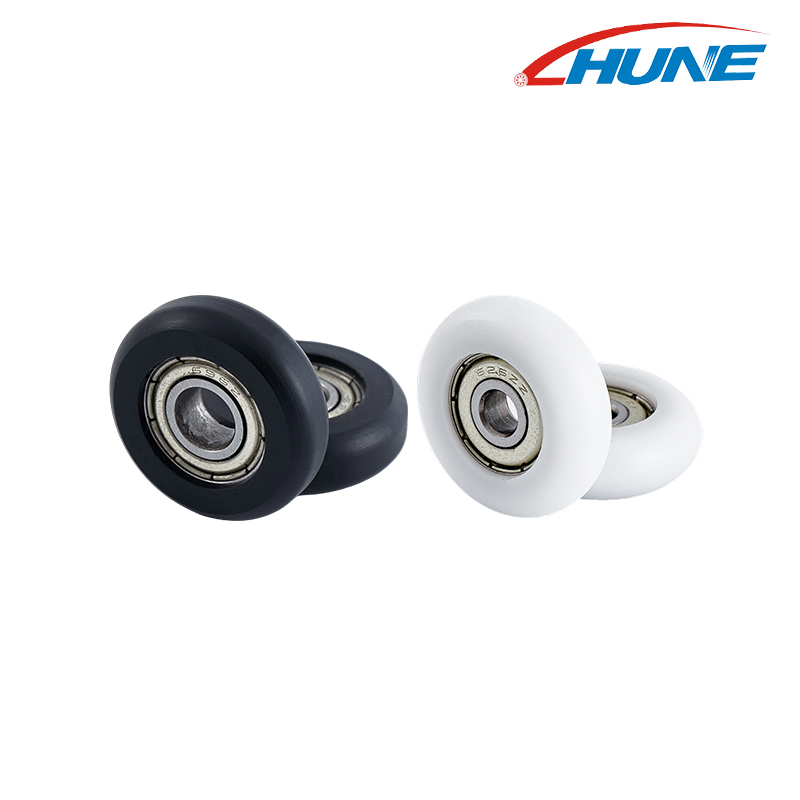






 English
English  Español
Español  日本語
日本語 